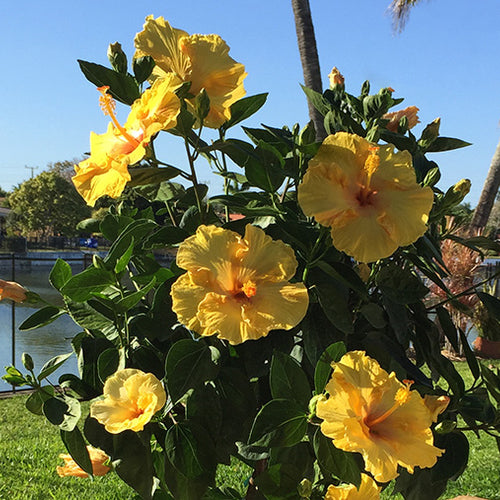We share easy tips for growing hibiscus.
Grow tropical hibiscus for a big, bold look in your yard, deck or patio. It’s the perfect plant to impress your friends with! Happily, it’s easy -- you don’t need to have a green thumb or be a master gardener to enjoy the sunning flowers. Here’s what you need to know.

Tropical HibiscusLight
How much light it take to grow tropical hibiscus (Hibiscus rosa-sinensis)? In general, as much as you can give it. Full sun, which means at least 6 hours of direct sun per day, is best for these exotic plants. You can enjoy hibiscus in half-day sun, but you typically don’t see as many blooms, and they may not be as large.
Note: In especially hot climates, some tropical hibiscus benefit from a little shade during the hottest part of the afternoon.
Temperature
That brings us to temperature. For the most part, hibiscus are pretty tolerant. But, because it is a tropical plant, it’s best to protect it from temperatures below about 50F (10C) or so. Tropical hibiscus can survive dips in temperature, but may show damage or even die back if it drops below about 35F (1.5C).
Though hibiscus are tropicals, they can suffer a bit if temperatures stay above 100F (37.5C) or so for extended periods. Temperatures like this can cause them to lose some flower buds and not produce as many new buds until temperatures cool again.
Water
Wondering how much you need to water? As with most plants, the general rule of thumb if you’re growing hibiscus in a pot is to add more moisture when the top inch of the potting mix dries to the touch. Depending on the size of the plant, the size of the pot, and the weather, that may be as little as once a week or as often as once a day.
Hibiscus-Growing Tip: The larger the pot is, the more potting mix it can hold. And that means it takes longer to dry out -- so you have to water less.
Fertilizer
It doesn’t take a lot of fertilizer to grow beautiful hibiscus. In fact, if you’re enjoying the plant as a summer annual, you may not need to fertilize much at all. But, you can add some fertilizer now and again to encourage your hibiscus to produce more blooms. Any general-purpose fertilizer labeled for potted plants will do. Follow the directions on the product packaging.
Note: The hibiscus we grow come with a time-release fertilizer already mixed in. This fertilizer slowly releases nutrients to the plant for a couple of months for you.
Pruning
Growing tropical hibiscus may mean a little pruning now and again, especially if you live in a frost-free climate and grow your plant outdoors all year long. Whether you’re in the North or South, you can keep your hibiscus plant tidy, if necessary, by pinching off the tips of the new growth. Doing so will cause your hibiscus to produce more side branches, keeping it full and bushy, rather than tall and lanky.
Does pruning affect flowering? Yes it does, but only a little. Because hibiscus bloom on new growth, cutting off the growth tips will delay flowering a little while the side branches develop. However, because you have more branches, and more new growth, you’ll often end up with more flowers.
Written by Justin Hancock









